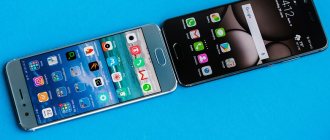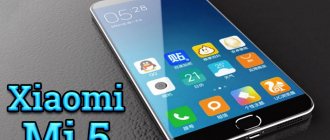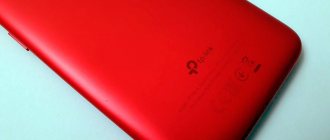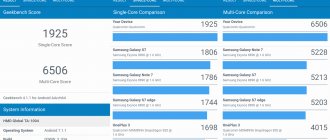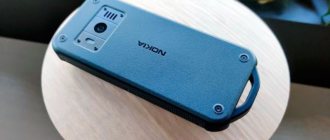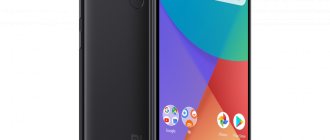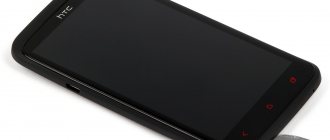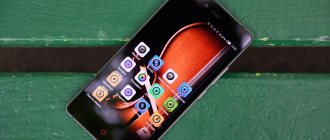In July 2020, the Finnish company HMD Global presented the Nokia 6.1 Plus (Nokia X6) smartphone for users of the global market. The returning Nokia, led by the new owner of the brand, managed to release several new products belonging to different price segments and satisfying many selection criteria. Twelve months ago, the high-quality Nokia 6 device was presented. This year, the six were modernized and the Nokia X6 smartphone was produced.
The device is entering the international electronics market under the name Nokia 6.1 Plus with some differences from the previous model. The mobile device is based on Android one without proprietary shells and has a modification of 4/64 GB of memory. The smartphone is not a budget phone, it has good characteristics and can gain popularity among middle-class models.
Table of contents
- Specifications
- Equipment and appearance
- Screen and sound
- Performance
- Autonomy
- Camera
- Software
- Results
This spring, HMD, which now owns the rights to the Nokia brand, introduced its new mid-budget smartphone Nokia x6. Initially it was sold only in China, but the model became popular, so it was decided to release it on the international market. Here it was called Nokia 6.1 Plus, the latest version of Android Pie and a very reasonable price.
conclusions
The Foxconn FIN Mobile division of the Finnish company HMD Global, which produces smartphones, has made a high-quality device, giving it a chic design and great functionality. The result is a nimble and reliable assistant. The device belongs to the middle price segment, but looks like a luxury phone.
According to reviews from a Chinese user, there are no complaints about the smartphone. The phone is in high demand and this is one of the main indicators of quality.
Specifications
| Frame | Metal, glass |
| Display | 5.8 inches, 1080 × 2280 pixels, IPS, Corning Gorilla Glass 3 |
| Platform | Qualcomm Snapdragon 636 processor, Adreno 509 GPU |
| RAM | 4 or 6 GB |
| Built-in memory | 64 GB, ability to install memory cards up to 256 GB |
| Cameras | Main – 16 MP and 5 MP; front - 16 MP |
| Connection | Combined slot for two nanoSIM and microSD memory card; 4G LTE: B1 (2,100), B3 (1,800), B5 (850), B7 (2,600), B34 (TDD 2,100), B38 (TDD 2,600), B39 (TDD 1,900), B40 (TDD 2 300) 3G: B1 (2 100), B2 (1 900), B5 (850), B8 (900) 2G: B2 (1 900), B3 (1 800), B5 (850), B8 (900) |
| Wireless interfaces | Wi-Fi 802.11 a/b/g/n 2.4 and 5 GHz, Bluetooth 5.0, GPS, GLONASS, BDS, A-GPS |
| Expansion slots | USB Type-C, 3.5 mm audio jack, microSD up to 256 GB |
| Sensors | Accelerometer, fingerprint scanner, geomagnetic sensor, proximity and light sensors |
| operating system | Android 9 Pie |
| Battery | 3,060 mAh (non-removable) |
| Dimensions | 147.2 × 70.9 × 8.0 mm |
| Weight | 151 g |
The smartphone is built on the popular Qualcomm Snapdragon 636 platform. It includes a 64-bit processor with eight Kryo 260 cores operating at frequencies up to 1.8 GHz. The Adreno 509 video accelerator is used to work with graphics, which makes it possible to run any modern mobile games.
Nokia 6.1 Plus comes with 4 or 6 GB of RAM, which is enough for fast and smooth running of applications during multitasking. A 64 GB e-MMC 5.1 drive is used as internal storage, of which about 50 GB is available for user needs. By today's standards this is not much, but for the first time it will be enough. And after filling, you can install an external memory card instead of the second SIM card.
The gadget boasts support for several geopositioning systems at once, which allows it to determine the location in just a few seconds. There is also dual-band Wi-Fi 802.11 a/b/g/n/ac, Bluetooth 5.0 and a full set of all necessary sensors.
Additional features
For active games
Avid gamers will be satisfied with the performance of the smartphone. The device showed good results for almost all hit toys. In “tanks” it shows constant 30-35 frames. At medium graphics settings you can get stable 60 frames. With prolonged use it heats up slightly.
Unlock
Face ID unlocks automatically. All you have to do is bring your smartphone to your face. The speed at which the phone turns on depends on the level of light around it. You can unlock your phone using a fingerprint sensor. Scanning occurs instantly and does not depend on the time of day.
Sound
The device has two microphones, one of them is used to record spatial audio when filming, and suppress noise during a conversation. In phone mode, callers hear clear speech without background noise. The multimedia speaker is not satisfactory. When playing video or music, loud and surround sound.
When using headphones, a pleasant bass sound with notes of velvet was noted; there were no complaints about vocals. Sound with a large volume reserve. When turning on the radio, no interference or extraneous noise was detected.
Manufacturers left the original ringtone to the Finnish company. It brings back memories of a time when Nokia phones were reliable and the best in the electronics market. Many of us rarely think about which company is better and which model to buy.
Wireless interfaces
The smartphone supports all types of wireless communications: Wi-Fi 802.11 (2.4 and 5 GHz) and Bluetooth version 5. Communication standard 4G, 3G, 2G. Supports GPS, A/GPS, GLONASS, BeiDou navigation systems.
Equipment and appearance
The Nokia 6.1 Plus box is strikingly different from all the Chinese smartphones we have reviewed recently. The designers designed it in a well-recognized style unique to Nokia.
But we were not impressed with the equipment. Inside, in addition to the smartphone itself, we found only a charger with a Chinese plug, a connecting cable and a transparent silicone case. You will have to buy headphones, a screen protector, and an adapter for European sockets yourself.
The main area of the front surface is occupied by the screen. It is surrounded by thin bezels, the thickness of which on the sides and top is less than 2 mm. The size of the under-screen space is 7 mm.
At the top, the notorious “unibrow” attracts attention, which houses the front camera and earpiece. The cutout is not wide, which made it possible to fit not only the clock indicator, but also several application icons nearby. If desired, the “bangs” can be disguised using a special option in the operating system settings.
The back cover of the Nokia 6.1 Plus smartphone is made of glass. In the center is a dual camera and flash unit, framed by a shiny protruding frame. The back cover has an oleophobic coating, so fingerprints collected by its glossy surface are erased with just one easy movement. However, there is a potential problem with this: on inclined surfaces, the phone slips and may fall. Therefore, it is better to wear a protective cover.
The side edges are made of dark matte metal. The power button and volume rocker are pressed with a slight click and do not wobble or rattle.
On the left side there is a combined tray for installing SIM cards and an external memory card.
In the center of the bottom edge there is a USB Type-C connector for charging and data exchange. On one side of it, behind two rectangular holes, an external speaker is hidden, and on the other, a microphone. On the top edge there is a 3.5 mm jack for connecting headphones.
Overall, we liked the device for its compact size, excellent design and high-quality materials. When we first started the review, we were afraid that this was just another Chinese smartphone. However, the look and feel of the Nokia 6.1 Plus lives up to the Finnish giant's former glory.
Nokia X6 - review and characteristics of a powerful mid-budget smartphone
We already wrote about this device in this article , but as it turned out, most of those leaks were not confirmed, which is a pity. Previously, we were expecting a more powerful smartphone with a slightly different design, but in the end everything turned out a little simpler, although it’s unlikely to say that the device was a failure. On the contrary, everything about him is good, unless, of course, you don’t take into account the unibrow that everyone has, and which so many still don’t love.
Design
Initially it was said that the Nokia X6 would look almost like a copy of the Nokia 7 Plus , only with a unibrow, but this did not happen. The device is of course similar to the Nokia 7 Plus, but this similarity can only be described as a feature of the modern design approach, nothing more. Let's start with the front panel, which is no different at all from what can be seen in competitors' smartphones: thin frames on three sides, a small chin at the bottom, a unibrow - a classic set of any device in 2020. The back of the Nokia X6 turned out to be very nice, in a minimalist style: a double vertical camera with a flash under a single rim, and under it a fingerprint scanner. Fortunately, all this is placed in the center and not shifted anywhere - both beautiful and recognizable. The smartphone itself is completely glass with a metal frame and has three colors: black, white, blue. Despite the fact that we have glass and not metal on the back, there is no smell of wireless charging. In general, the Nokia X6 looks attractive and it clearly looks more expensive than it actually is.
Screen and performance
They decided to make the display diagonal in the Nokia X6 at the golden mean - 5.8 inches. The resolution does not exceed Full HD+ 2280x1080 pixels, and the aspect ratio is 19:9. The IPS matrix type, which is quite expected, has a pixel density of 435 ppi, and occupies the display about 81% of the front panel area. The protective glass used is a good solution, Goring Gorilla Glass 3, with a decent oleophobic coating.
Before the release of the Nokia X6, there were rumors that the device would be released in two versions, namely on the Snapdragon 660 and separately on the Mediatek Helio P60. Oppo and Vivo are already practicing this, and successfully, so no one doubted that Nokia would bring this idea to life. However, this did not happen and we received a strong stone as a processor in the form of Snapdragon 636. You can read in detail about this solution here, so we will not delve into its characteristics (they will also be described below in the full list of specifications). Considering also that Nokia 6 will receive from 4 to 6 GB of RAM and from 32 to 64 GB of permanent memory, the device’s performance will be enough for everything planned. Games on the Snapdragon 636 are known to run very well, so for those who like to play, the Nokia X6 is definitely suitable.
Cameras and autonomy
The Nokia X6 has a dual camera and consists of a 16 MP main module with f/2.0 lens aperture + a 5 MP secondary module with f/2.2 aperture. By the way, the additional sensor is monochrome and has a pixel size of 1.2 microns, and the main sensor is color with a pixel size of 1 microns. Now it’s difficult to say how the new product will take photographs, but you can hardly expect excellent results, because its lenses are not fast, the pixel size is minimal, and there is no optical stabilization. The Nokia X6 can perform well only during daylight hours, while in the absence of light you can expect strong noise or soapy noise with aggressive noise reduction, eternal blurring, etc. Like all smartphones from competitors, Nokia X6 supports AI, which is responsible for portrait mode, exposure settings, and more. In addition, the new product supports proprietary Bothie technology, which allows you to shoot simultaneously on the front and main cameras.
At the same time, the front camera in the device completely replicates the main one, that is, it also has a 16 MP sensor with a pixel size of 1 micron and an f/2.0 aperture. For the front camera, these parameters are more than good, so selfies on the Nokia X6 will turn out excellent (in good light, of course). The smartphone also supports face unlocking, although there is nothing surprising here.
With autonomy, everything is more or less in order, although 3060 mAh is unlikely to delight anyone. This capacity is not enough for a smartphone, or rather, the charge is enough for one day, but no more. However, there is a positive aspect in this whole story, such as support for fast charging Qualcomm Quick Charge 3.0, which fills the battery from 0 to 50% in just 30 minutes.
Screen and sound
The smartphone has a 5.8-inch display with a resolution of 1,080 × 2,280 pixels. The fonts and icons on the screen look great. There's not even a hint of grain or pixelation.
A high-quality IPS matrix demonstrates wide viewing angles, correct color reproduction and good contrast. The brightness varies over a wide range, which allows you to use the device both in poor artificial lighting and in bright sunlight. There is automatic backlight adjustment depending on the environment and a special reading mode that reduces eye strain.
If you have high-quality headphones, Nokia 6.1 Plus will delight you with excellent loud sound with a full spectrum of frequencies and a wide stage. The work of the external speaker cannot boast of the same excellent characteristics, but it cannot be called bad either. Suitable for voicing ringtones and notifications.
Network services
Page 10
- Text
When connecting another device, read the technical rules
safety instructions given in the instruction manual
the corresponding device. Do not connect incompatible devices. The images in this manual may differ from those shown on
display. For other important information about the device, see the instruction manual.
Network services
Operation of the device is only possible if there is maintenance,
provided by your cellular service provider. In some cell phones
networks, not all functions are implemented; in addition, for the use of some
functions require a special agreement with the supplier
services. The use of network services involves the transfer of data. Specify
information about the cost of services in the home network and when roaming through other networks
from the service provider. Tariff information is provided by the service provider.
Some cellular networks have restrictions on the use of some
functions of this device that require network support,
for example, support for certain technologies such as WAP protocols
2.0 (HTTP and SSL), which run on TCP/IP protocols, and characters
national alphabets. Your service provider may block some features of your device.
In this case, these functions will not be available in the menu. The device can also
be specially configured: menu names, menu order are changed
and icons.
10 Safety precautions
© 2010 Nokia. All rights reserved.
No image, show text version
Comments
Select → I found the instructions for my cell phone here! #manualza
- Click →
Very simple guys serve in remote missile garrisons and are not afraid to write clear instructions. For example, in one instruction of the missile unit of the Siberian Military District there was the following entry: “The operator on duty is prohibited from sleeping with his head on the control panel of the missile launcher, so that drool from his open mouth does not short-circuit the electrical contacts.”
Manualza!manualza.ru
Still not with us?
Performance
The Snapdragon 636 platform used in Nokia 6.1 Plus has proven itself in such hits as Lenovo Z5 or Xiaomi Redmi Note 5. Its performance is enough to solve any user tasks, which is fully confirmed by our testing.
Compared to the performance of flagships, the results do not look very convincing, but let’s not forget that this is a smartphone that costs 15,000 rubles. In real life, the Nokia 6.1 Plus is surprisingly fast and smooth. Good software optimization, which we will discuss in detail below, and a large amount of RAM allow the smartphone to easily cope with even the most resource-intensive applications.
The situation with games is typical for smartphones based on the Snapdragon 636 platform. You can run almost any game on the Nokia 6.1 Plus, but for the most advanced ones you will have to reduce the picture quality. It is commendable that the smartphone does not get too hot even during heated battles.
Nokia X6 - detailed review of the mobile phone
In the future, the X6 was considered by the creators as a replacement (continuation) of the Nokia 5800 model. The Finnish company needed to expand this series of phones (Xpress Music) and improve it.
If we talk about the external differences between the phones, it is worth noting that the annoying and protruding side of the 5800 in the X6 was replaced with a metal cast. This update has seriously changed the design of the phone for the better. The buttons both look and feel more pleasant. But, nevertheless, the main update is the screen; in the X6 model, for the first time for Nokia phones, a capacitive screen was used, and not a resistive one, as in most models. Capacitive screens last longer, contain deeper colors, and are generally more transparent.
As a result, we get a fairly powerful music smartphone, a fairly convenient package, with many functions and high performance.
Autonomy
If the Nokia 6.1 Plus scored mostly positive marks on all the previous points, unfortunately, nothing good can be said in terms of autonomy. The capacity of the installed battery is 3,060 mAh - for a device with a Full HD screen and not the most modern processor, this is catastrophically small.
With standard use, you can count on one day of battery life – and that’s only if you don’t load the Nokia 6.1 Plus with heavy tasks or games. However, for those users who are used to charging their smartphone every evening, this should not be a big problem.
Nokia 6.1 Plus supports fast charging, but the bundled device does not provide this feature. Therefore, if you do not want to waste extra time, you will have to look for a third-party power supply.
Nokia X6 repair
Since Nokia's X6 is an improved version of the 5800, it is similar in many ways to its prototype, but has fewer repairs than the typical 5800 problems. Firstly, adding thirty-two gigabytes of my memory without a card halved the amount of repair work. Instead of two directions of breakdowns, now everything is solved using only one. The touch screen, on the contrary, added work - there is an uneven distribution of touch functions across the entire screen, and there are breakdowns that affect the quality of color display. But capacitive screens, unlike resistive screens, break less often.
We are often approached by beginners who cannot independently figure out the settings for listening to audio files of different extensions. But basically the breakdowns are the same as with regular phones for young people - shocks, moisture and other signs of inattentive care of the device. There are many independent sloppy break-ins and damage caused during independent adjustments or repairs. Calls to service centers with functional disorders are more common than with mechanical breakdowns.
Camera
In years past, Nokia devices were famous for their excellent photo quality. I'm glad that Nokia 6.1 Plus continues this tradition.
The smartphone has a dual main camera with 16 and 5 megapixel modules. The software allows you to shoot in both fully automatic and manual mode. In the latter case, you can independently set the white balance, exposure and some other parameters. If the standard camera application does not suit you, you can install Google Camera. The program is famous for the quality of its pictures, especially night ones.
In good lighting, Nokia 6.1 Plus produces excellent quality photos. We've tested a lot of smartphones this year, but this one seems to be one of the best. There is no artificial intelligence or other fancy things here, but nevertheless, the output is bright photos with the correct white balance and a wide dynamic range.
In low light conditions, photos turn out slightly worse. But then we remembered about the special Night Sight night shooting mode in Google Camera. It allows you to take bright pictures in low-light conditions even without using flash or other light sources. The result was beyond praise, as you can see for yourself in the test images.
The device supports several data exchange methods and...
Page 9
- Image
- Text
The device supports several data exchange methods and, like
computers, device may be exposed to viruses and other
harmful content. Use caution when working with
messages and communication requests, browsing and downloading
data. Install and use services and other software
provision only from sources with reliable protection, for example,
applications with a digital signature of Symbian Signed or passed
Java Verified™ testing. You should install antivirus and other
security software both in the device and on any
connected computer. The device can be programmed with bookmarks and links to nodes
third parties to access them. They are not Nokia related, and
Nokia Corporation makes no representations or assumes any
no obligations regarding these nodes. Looking through these nodes,
precautions must be taken (in terms of protection and in terms of
content).
Attention!
To operate any device functions (except alarm clock)
requires the device to be turned on. Do not turn on the device if
its use may cause interference or be dangerous.
When using this device, strictly comply with the laws
local customs, respect the right to privacy and do not violate legal
rights of others, including copyrights. Protection legislation
copyright imposes restrictions on copying, modification and
transfer of some images, ringtones and other content. Regularly create backup copies (electronic or paper) of all
important data stored in the device.
Safety precautions
9
© 2010 Nokia. All rights reserved.
Software
The Nokia 6.1 Plus smartphone was released as part of the Android One program, so it has a clean image of the operating system installed on it. Moreover, the device will receive all patches and updates first. We were able to verify this ourselves when, immediately after unpacking, it was updated to Android 9 Pie.
A lot of articles have been written about the features of Android 9, so we won’t go into detail about all the features. Let's just say that the OS did not cause us any complaints. The new method of gesture control works flawlessly, the facial recognition system identifies the owner without errors, “Digital Well-being” keeps statistics on application use, and machine learning algorithms allow you to save battery power based on an analysis of the user’s habits. Perhaps there are some errors in the operation of the operating system - after all, this is a completely new version, but we did not encounter them during testing.
Also in the new version of the operating system, the design was significantly redesigned, which was called Material Theming. This applies to colors, design elements, new icons, notifications, settings and many other components.
As we already mentioned, Nokia 6.1 Plus was initially released only for China. Some online stores continue to sell these devices, without saying that they do not have the necessary languages and Google services. Therefore, pay attention to the firmware version: it must be international (Global). For example, the smartphone that was sent to us from the GearBest store initially has the Russian language, the Google Play store and support for updates. The buyer only needs to add his account, install the necessary programs and start using the device.
Nokia X User Guide...
Nokia cell phones
- Image
- Text
- Content
Nokia X6-00 User Manual
Issue 4
- Nokia X6-00 User Guide Contents
- Safety precautions SAFE STARTING
- ROAD SAFETY FIRST
- RADIO INTERFERENCE
- TURN OFF IN PLACES WHERE USE IS PROHIBITED
- CONTACT QUALIFIED PROFESSIONALS ONLY
- ACCESSORIES AND BATTERIES
- WATER RESISTANCE
- GLASS PARTS
- About the device
- Network services
- Keys and components
- Device Help
- Phone setup
- Using the touch screen during calls
- Call lists
- Automatic input modes
- Saving and changing names and numbers
- Messages home screen
- Defining email settings
- Text message settings
- About Ovi Contacts
- Changing the appearance of your device
- Music player Play a tune or podcast
- Podcasting Settings
- Listening to the radio
- View and organize files
- Turn on the camera
- Record a video clip
- About GPS
- Map overview
- Data connections and access points
- Creating a new access point
- Bluetooth communication channel
- Param. SIP
- Exchange on the Internet
- View and download video clips
- Internet browsing
- About search
- Clock Setting the time and date
- Calendar Screens
- About File Manager
- About Quickoffice
- Application Manager
- RealPlayer Toolbar
- Phone settings Date and time settings
- Settings call
- Accessories
- Disposal
- Children
Case design and materials
Dimensions: 111 x 51 x 14, weight: 122 grams. The body is a classic rectangle with rounded edges at the top and bottom. The corners are beveled. The external design of the device resembles that of the company’s slider models. Most of the front panel is occupied by the display. On top of it lies a protective glass, which, alas, despite the company’s efforts, gets scratched, and quite quickly. The main body material is plastic, which is quite normal for most flagships of that time (even those running Android). There are metal parts, namely frames around the edges. The body parts fit together well, but not completely; there are small gaps that quickly become clogged with small debris and dust. There is a small, but still noticeable play in the back cover. The device comes in several colors:
- White and blue.
- Yellow-white.
- Pink and white.
- Black and red.
- Black.
